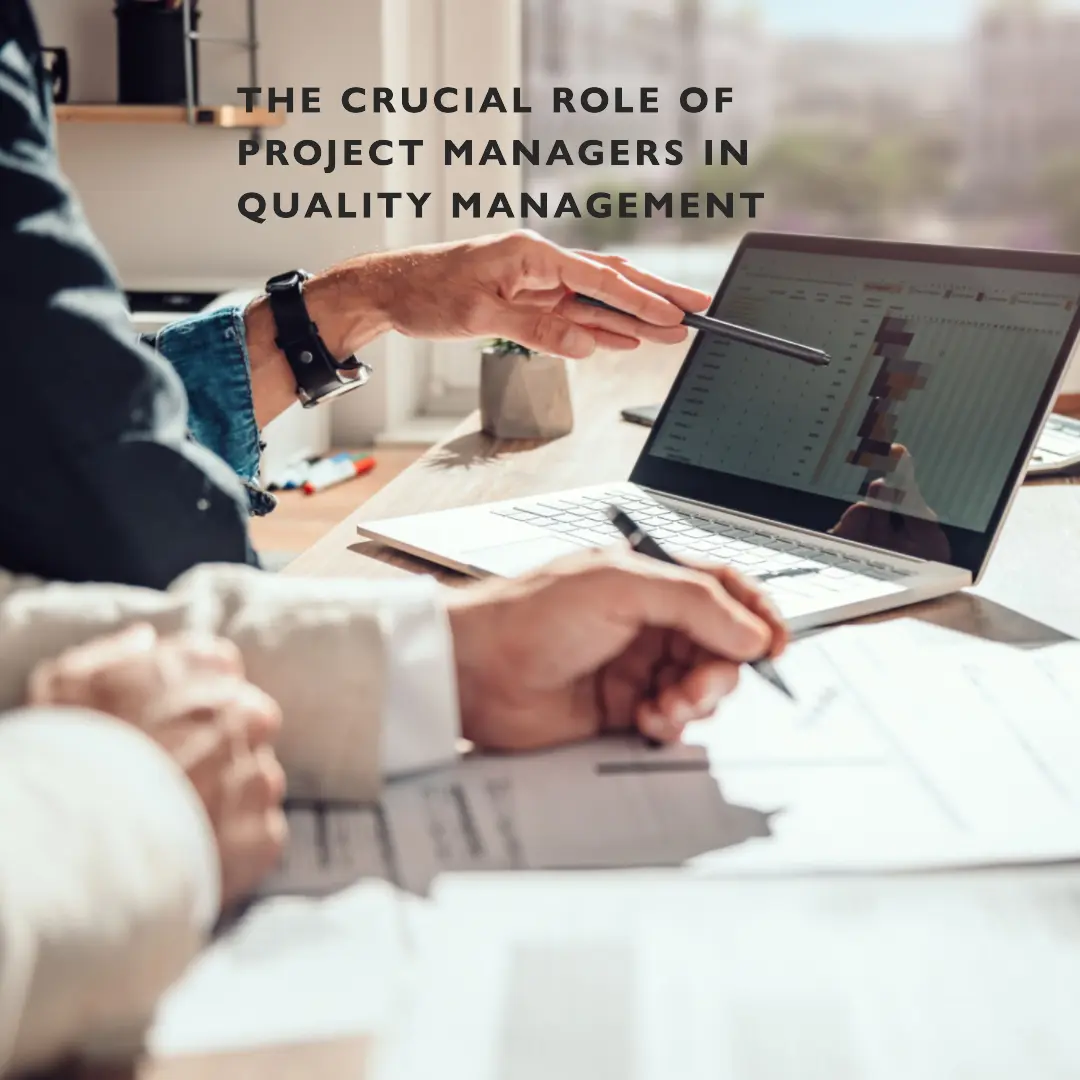To find out how Artificial Intelligence is changing the Project Management landscape, you may enjoy reading this article https://www.shaunstoltz.com/did-artificial-intelligence-just-change-everything-about-project-management/
I. Introduction
Hey there, fellow project management enthusiasts! Today, we’re going to dive into a topic that is near and dear to my heart: the crucial role of project managers in quality management. In my years of experience managing projects across various industries, I’ve realized that ensuring project quality is not just a responsibility, but an art that every project manager should master. In fact, it’s a crucial factor that can make or break a project’s success.
A. Importance of quality management in projects
But why is quality management so important, you may ask? Well, let me paint you a picture. Imagine working on a project for months, pouring your heart and soul into it, only to find out that the final product doesn’t meet the expectations of your stakeholders. Ouch! That’s a hard pill to swallow.
Quality management helps us avoid such scenarios. It’s the process of ensuring that a project’s deliverables meet the required standards and expectations. And when we consistently deliver high-quality results, we can boost customer satisfaction, reduce risks and costs, and enhance our organization’s reputation. Sounds pretty awesome, right?
B. The critical role of project managers in quality management
Now, let’s talk about the heroes of this story: project managers. As a project manager, you are the ultimate guardian of your project’s quality. From planning and monitoring to stakeholder communication and team leadership, it’s your job to make sure that quality remains at the forefront of every aspect of the project. No pressure, right?
But don’t worry! In this blog post, we’ll break down the responsibilities of project managers in ensuring project quality, so you’ll be well-equipped to tackle this vital aspect of your job. Grab your favorite beverage, and let’s get started on this exciting journey!
II. The Project Manager’s Role in Quality Planning
Welcome back, friends! In this section, we’ll explore the first crucial step every project manager must take in their quest for quality: planning. As the old saying goes, “Failing to plan is planning to fail,” and this couldn’t be more true when it comes to quality management. So, buckle up as we delve into the essential components of quality planning for project managers.
A. Identifying quality requirements and standards
First things first, we need to know what “quality” means for our specific project. This involves identifying the quality requirements and standards that our deliverables must meet. In my experience, the best way to do this is by collaborating closely with our stakeholders. After all, they’re the ones who’ll be judging the final product.
Don’t be afraid to ask questions and dig deep to understand their expectations. You can also research industry standards, regulations, and best practices to ensure your project aligns with what’s considered top-notch in your field.
B. Developing a quality management plan
Once you have a clear understanding of the quality requirements, it’s time to create a roadmap—a quality management plan. This plan will outline how you’ll achieve and maintain the desired quality levels throughout the project. It should cover everything from quality objectives and processes to roles and responsibilities.
I like to think of the quality management plan as my project’s safety net. It keeps me and my team focused on what really matters: delivering a fantastic end product that meets or even exceeds stakeholder expectations.
C. Establishing quality metrics and benchmarks
Now that we have a plan, how do we measure our progress? This is where quality metrics and benchmarks come in handy. They provide us with tangible, quantifiable ways to track our project’s quality performance.
Choose metrics that are relevant to your project’s goals and deliverables. For example, if you’re working on a software development project, you might track the number of bugs or defects per release. Setting clear benchmarks will help you identify potential quality issues early on, giving you a chance to address them before they snowball into bigger problems.
D. Integrating quality management into overall project planning
Lastly, it’s essential to weave quality management into the very fabric of your project. In other words, quality shouldn’t be an afterthought or a separate aspect of your planning process. Instead, consider it an integral part of everything you do.
When creating your project schedule, budget, and resource allocation, always keep quality requirements in mind. This holistic approach will ensure that your entire team stays committed to delivering excellence at every stage of the project.
And there you have it! These are the key elements of quality planning for project managers. By laying a solid foundation for quality management, you’ll be well on your way to delivering projects that make you and your stakeholders proud. Stay tuned for our next section, where we’ll discuss monitoring and controlling project quality!
III. Monitoring and Controlling Project Quality
Hello again, project management aficionados! Now that we’ve laid the groundwork with quality planning, it’s time to shift gears and talk about the ongoing process of monitoring and controlling project quality. In this section, we’ll explore the key strategies you, as a project manager, can use to keep your project’s quality on track and continuously improve your processes. Ready? Let’s dive in!
A. Implementing quality assurance processes
Quality assurance is all about being proactive. It involves putting processes and systems in place to ensure your project consistently meets the established quality standards. Think of it as a safety net that helps you catch potential issues before they turn into major problems.
One way to implement quality assurance is by adopting best practices, methodologies, or frameworks relevant to your industry. For example, in software development, you might use agile methodologies to promote iterative development and continuous improvement.
B. Conducting regular quality audits and reviews
As a project manager, it’s crucial to keep a close eye on your project’s quality performance. Regular quality audits and reviews can help you do just that. These assessments should evaluate whether your project is adhering to the established quality management plan, standards, and benchmarks.
I find it helpful to schedule these audits at predefined intervals or milestones, as it keeps my team and me accountable and focused on delivering quality results.
C. Identifying and addressing quality issues
No project is perfect, and you’re bound to encounter some quality issues along the way. When this happens, it’s important to identify and address them quickly and effectively. A great way to do this is by establishing a process for reporting and resolving quality issues, such as a defect tracking system or a continuous improvement loop.
Encourage your team to be proactive in identifying and reporting issues, and work together to find solutions that improve the overall quality of the project.
D. Ensuring compliance with quality standards and requirements
As the project progresses, it’s essential to regularly verify that your deliverables meet the defined quality requirements and standards. This can be achieved through various methods, such as inspections, testing, or peer reviews.
Remember, compliance is not just about meeting the minimum requirements—it’s about striving for excellence and exceeding stakeholder expectations whenever possible.
E. Continuously improving project processes
One of my favorite aspects of quality management is that it encourages us to continuously learn and grow. As a project manager, you should always be looking for ways to improve your project processes, making them more efficient and effective.
Embrace feedback from your team, stakeholders, and even past project experiences. Use this valuable information to fine-tune your approach and raise the bar for quality in your projects.
And that’s a wrap on monitoring and controlling project quality! By keeping a close eye on your project’s quality performance and proactively addressing issues, you’ll be well on your way to delivering outstanding results. Next up, we’ll tackle the essential skill of effective stakeholder communication. Stay tuned!
IV. Effective Stakeholder Communication
Welcome back, project management enthusiasts! In this section, we’ll discuss a skill that is vital not only for quality management but for the overall success of your projects: effective stakeholder communication. Mastering this skill can make all the difference between a project that thrives and one that barely survives. So, let’s dive in and discover how you, as a project manager, can excel in stakeholder communication to ensure project quality.
A. Setting quality expectations with stakeholders
One of the most important aspects of stakeholder communication is setting clear and realistic quality expectations right from the get-go. By involving stakeholders in the quality planning process and ensuring their requirements are well-understood, you’ll create a solid foundation for the entire project.
Pro tip: Keep stakeholders informed about the trade-offs and constraints involved in achieving the desired quality. This transparency will help you manage their expectations and avoid any unpleasant surprises down the line.
B. Communicating project progress and quality status
Now that expectations are set, it’s essential to keep stakeholders in the loop throughout the project. Regularly update them on project progress, as well as the status of quality metrics and benchmarks. This not only keeps them engaged but also helps build trust and credibility.
Remember, communication is a two-way street. Encourage stakeholders to share their feedback, concerns, and suggestions, and be receptive to their input.
C. Involving stakeholders in quality management and improvement initiatives
Speaking of stakeholder input, why not involve them directly in your quality management efforts? After all, they have a vested interest in the project’s success and can offer valuable insights to improve quality.
Consider inviting key stakeholders to participate in quality audits, reviews, or brainstorming sessions for process improvement. This collaborative approach can help foster a sense of ownership and commitment to the project’s quality.
D. Managing stakeholder feedback and incorporating it into project processes
As you receive feedback from stakeholders, it’s important to carefully evaluate it and determine how it can be incorporated into your project processes. This may involve updating your quality management plan, adjusting your quality metrics, or implementing new improvement initiatives.
Be sure to communicate any changes to your team and stakeholders, and thank them for their valuable input. This will demonstrate your commitment to continuous improvement and stakeholder satisfaction.
And there you have it—effective stakeholder communication for quality management! By keeping stakeholders informed, engaged, and involved in your quality efforts, you’ll pave the way for a successful project that meets or exceeds expectations. Up next, we’ll explore the art of leading a high-performing team in pursuit of project quality. Stay tuned!
V. Leading a High-Performing Team
Hello again, project management superstars! As we continue our deep dive into the world of quality management, it’s time to focus on one of the most important aspects of any project: the team. After all, it’s the hard work, dedication, and expertise of your team members that ultimately determine the quality of your project’s deliverables. So, let’s explore how you, as a project manager, can lead a high-performing team that’s committed to delivering top-notch quality.
A. Building a team culture focused on quality
The first step in creating a team that’s passionate about quality is fostering a culture that values and prioritizes it. Start by clearly communicating your project’s quality objectives and expectations to your team members. Make sure they understand the importance of quality and how it contributes to the overall success of the project.
Next, lead by example. Show your commitment to quality in everything you do, from planning and decision-making to problem-solving and communication. Your team will be more likely to follow suit if they see you walking the walk.
B. Developing team members’ quality management skills
To ensure your team members can effectively contribute to your project’s quality, it’s essential to invest in their development. Offer training, resources, and support to help them build their quality management skills.
This can include workshops on quality methodologies, tools, and techniques, as well as opportunities for peer learning and knowledge sharing. Encourage your team members to continuously hone their skills and stay up-to-date with industry best practices.
C. Encouraging open communication and collaboration for quality improvement
A high-performing team is one that communicates openly and collaborates effectively. Encourage your team members to share their ideas, concerns, and suggestions for improving project quality. Create an environment where everyone feels comfortable speaking up and contributing to the quality conversation.
Additionally, promote collaboration between team members, as well as with stakeholders, to leverage diverse perspectives and expertise in your quest for quality improvement.
D. Recognizing and rewarding team members for their contributions to quality
Last but not least, don’t forget to celebrate your team’s quality achievements! Recognizing and rewarding team members for their hard work and dedication to quality can boost morale and motivation, leading to even better results.
Consider implementing a system for acknowledging quality-related milestones, such as successfully meeting quality benchmarks, implementing process improvements, or receiving positive stakeholder feedback. This can be as simple as a heartfelt “thank you” or as elaborate as a team celebration or award ceremony.
And there you have it—your recipe for leading a high-performing team that’s committed to project quality! By fostering a culture of quality, investing in your team’s development, and promoting open communication and collaboration, you’ll be well on your way to delivering exceptional results. Next up, we’ll discuss the impact of effective quality management on project success. Stay tuned!
VI. The Impact of Effective Quality Management on Project Success
Hello, project management champions! We’ve covered a lot of ground in our journey through quality management, from planning and monitoring to stakeholder communication and team leadership. Now, let’s take a moment to reflect on the big picture: the impact of effective quality management on project success. Ready to see how all your hard work pays off? Let’s dive in!
A. Increased customer satisfaction and loyalty
When you consistently deliver high-quality results, you’re bound to make your customers happy. And we all know that a happy customer is a loyal customer. By focusing on quality management, you’ll not only meet but exceed customer expectations, leading to increased satisfaction and loyalty. This, in turn, can open the door to repeat business, referrals, and glowing testimonials—all of which can contribute to your organization’s long-term success.
B. Improved reputation and competitiveness
A strong track record of delivering top-notch quality can significantly enhance your organization’s reputation in the marketplace. This not only attracts new customers but also helps you stand out from the competition. In today’s fast-paced, ever-evolving business landscape, a stellar reputation for quality can be a powerful differentiator that sets you apart and helps you stay ahead of the curve.
C. Reduced risks, costs, and rework
Effective quality management can help you identify and address potential issues early on, reducing the likelihood of costly surprises down the line. By proactively managing quality, you’ll minimize the risk of project delays, cost overruns, and rework—all of which can strain resources and jeopardize project success.
D. Enhanced team performance and morale
Let’s not forget the impact of quality management on your most valuable asset: your team. When you create a culture that values and prioritizes quality, your team members are more likely to feel motivated, engaged, and committed to the project. This not only leads to better performance but also fosters a positive work environment that attracts and retains top talent.
E. Greater overall project success
When you put it all together, it’s clear that effective quality management plays a crucial role in determining the overall success of your projects. By delivering high-quality results that meet or exceed expectations, you’ll boost your organization’s reputation, reduce risks, and pave the way for future success.
And there you have it, my fellow project management enthusiasts! We’ve reached the end of our journey through the crucial role of project managers in quality management. I hope you’ve found these insights helpful and inspiring as you continue to hone your skills and strive for excellence in your projects. Remember, quality is not just a responsibility—it’s an art, and as a project manager, you have the power to make a meaningful impact on your organization’s success. So, go forth and conquer the world of quality management!
VII. Conclusion: Embracing Your Role as a Quality Champion
Well, my project management friends, we’ve come a long way on this quality management adventure! Together, we’ve explored the many facets of a project manager’s role in ensuring project quality, from planning and monitoring to stakeholder communication and team leadership. As we wrap up this journey, let’s take a moment to reflect on the key takeaways and how you can embrace your role as a quality champion.
A. Quality management is an ongoing process
Remember, quality management isn’t a one-time task or something you check off your to-do list. It’s a continuous, iterative process that requires your dedication and attention throughout the entire project lifecycle. So, keep your eyes on the prize and stay committed to quality, even as you juggle multiple responsibilities and priorities.
B. Collaboration is key
Quality management isn’t a solo mission. It involves working closely with stakeholders, team members, and even other project managers to identify and address quality-related challenges. Embrace collaboration and open communication as your allies in your quest for project excellence.
C. Continuous improvement is the name of the game
As a project manager, you should always be looking for ways to improve your processes, methodologies, and techniques. Adopt a growth mindset and stay open to learning from your experiences, feedback, and industry trends. This commitment to continuous improvement will not only enhance your project’s quality but also help you grow and evolve as a professional.
D. Lead by example
To foster a culture of quality within your team, it’s essential to lead by example. Show your commitment to quality in everything you do, from planning and decision-making to problem-solving and communication. This will inspire your team members to follow suit and prioritize quality in their own work.
E. Celebrate your quality achievements
Last but not least, don’t forget to recognize and celebrate your project’s quality milestones and achievements. This not only boosts morale and motivation but also reinforces the importance of quality management within your organization.
Find out more about Shaun Stoltz https://www.shaunstoltz.com/about/
This post was written by an AI and reviewed/edited by a human.



